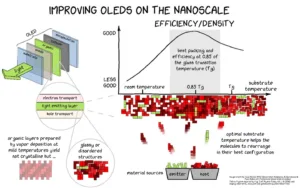Joan Ràfols-Ribé, heading a team of researchers from the Group of Nanomaterials and Microsystems, Universitat Autònoma de Barcelona (Bellaterra, Spain), the Dresden Integrated Center for Applied Physics and Photonic Materials and the Institute for Applied Physics, Technische Universität Dresden (Dresden, Germany), is developing a simple way to improve the efficiency of OLEDs. The team’s approach is based on adjusting the deposition temperature of functional films common to a wide variety of OLEDs and serves to improve the films’ thermodynamic stability. The improvement in efficiency is reported to exceed 15%, be applied across a range of OLED devices and be accomplished without a change in the configuration or materials used in the device.
A recent article on this research published by the team is entitled “High-performance organic light-emitting diodes comprising ultrastable glass layers.” It was published Sci. Adv. 2018; 4: eaar8332 on May 25th. A copy of the article can be found here.
First, a few words of background.
A practical reality in conventional OLED technology is that device efficiency (thus, brightness) has an inverse relationship with device lifetime. A great deal of previous research to address this issue and improve both brightness and lifetime has centered on developing improved OLED emitter materials or optimizing the OLED stack so as to improve the extraction of light from the device. These approaches are, however, typically specific to individual device designs and their viability effected by cost and scale-up considerations.
In their most recent research, the team investigated an approach to address the brightness/lifetime issue that is based on the means by which the organic layers are grown in OLED devices. More specifically, the team investigated the effects of slowing down the rate of physical vapor deposition, a process commonly used in OLED fabrication, and performing the deposition at a temperature of about 85% of the substrate’s glass-transition temperature (Tg). Such deposition conditions were known to produce so-called ultrastable glass layers.
In their investigation, the team used test devices that consisted of a simple OLED stack containing two organic layers. One served as the both the emissive layer (EML) and the electron transport layer (ETL). The other functioned as the hole transport layer (HTL). The HTL had what the team called a “technically feasible” glass transition temperature.
The graphic below illustrates the configuration of the test OLED devices as well as provides comments on the effects of deposition temperature on character of the layers.
A graphic illustrating the configuration of the test OLED devices and the effects of deposition temperature on the character of the organic layers.
Red, green and blue OLED devices were fabricated using several phosphorescent emitters and a number of different physical vapor deposition temperatures. The researchers then tested the resulting prototypes evaluating two parameters:
- External quantum efficiency (EQE) at a luminance of 100 cd/m².
- LT70 lifetimes. (This is the time it takes for the device luminance to fall to 70% of its initial value.)
The technical article published by the team contains a great deal of information on the means of measurement and the interpretation of the results. The bottom line is that both parameters showed a greater than 15% enhancement relative to reference devices made with conventional layers. In fact, some of the prototypes showed an improvement that was far better.
The researchers also undertook a detailed analysis to determine the reason why the use of ultrastable glass improved the quantum efficiency of the devices. Their work suggests “the enhancement in EQE is related to differences in exciton dynamics at the nanoscale that lead to a better radiative efficiency for the emissive layer.”
Paraphrasing the conclusion in their article, the team believes that the enhancements presented by their work can be applied to a wide range of OLED stacks and device designs and that their approach has the potential to increase in both OLED brightness and device lifetime. The concept of incorporating ultrastable glass layers is independent of the emitter technology used. The implication of this fact is that OLEDs can be based on a high performance emitter, such as phosphorescence as discussed in their recent work, or TADF. The caveat is that the emitter orientation is not hampered at the respective substrate temperature.
Future research needs to “investigate material and device properties, which could possibly counteract the observed effects. The influence of the material deposition conditions on the charge carrier transport of organic small molecules must be correlated to solely excitonic effects to achieve a complete understanding.” -Arthur Berman
Technische Universität Dresden, Sebastian Reineke, [email protected]

